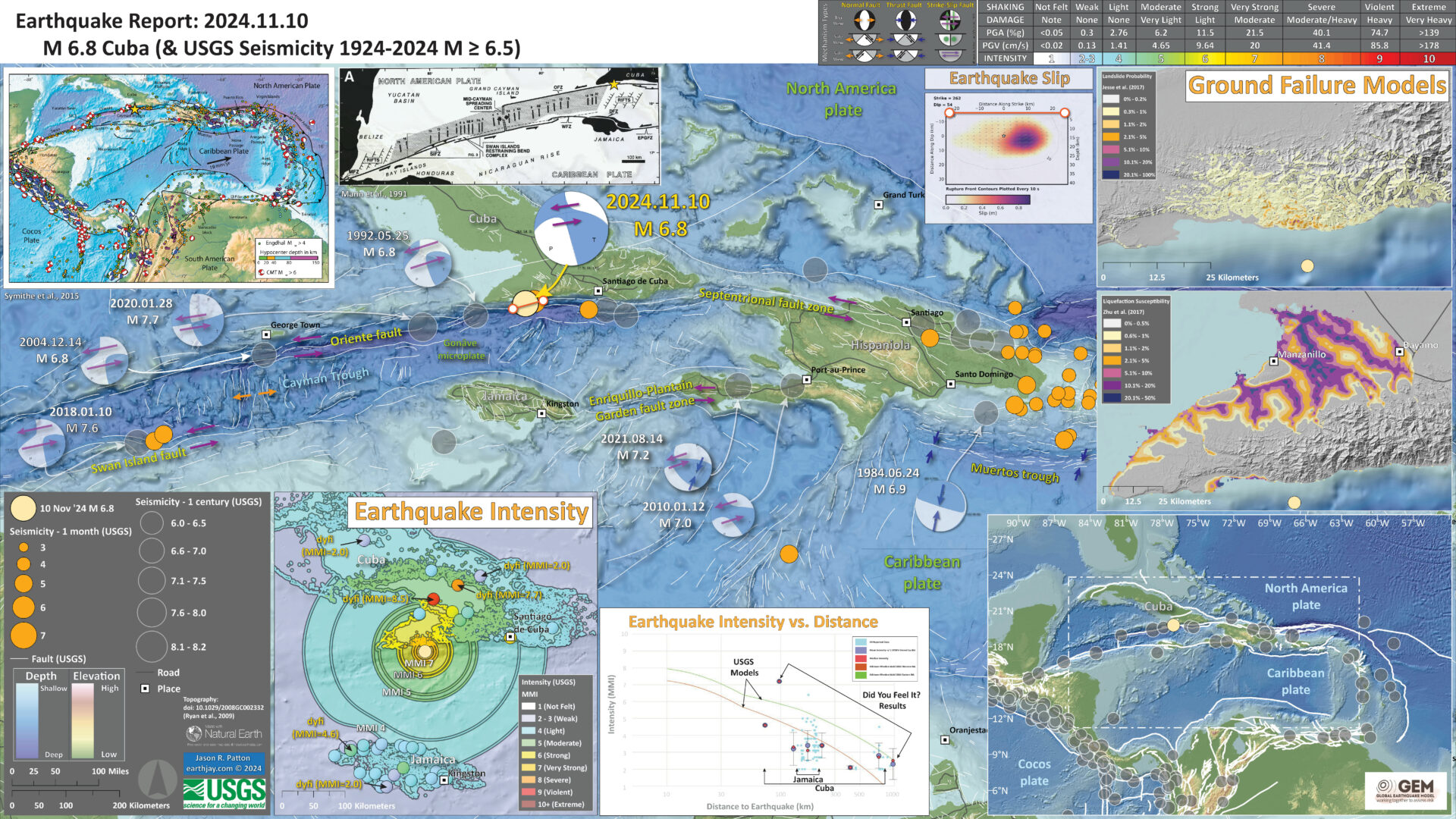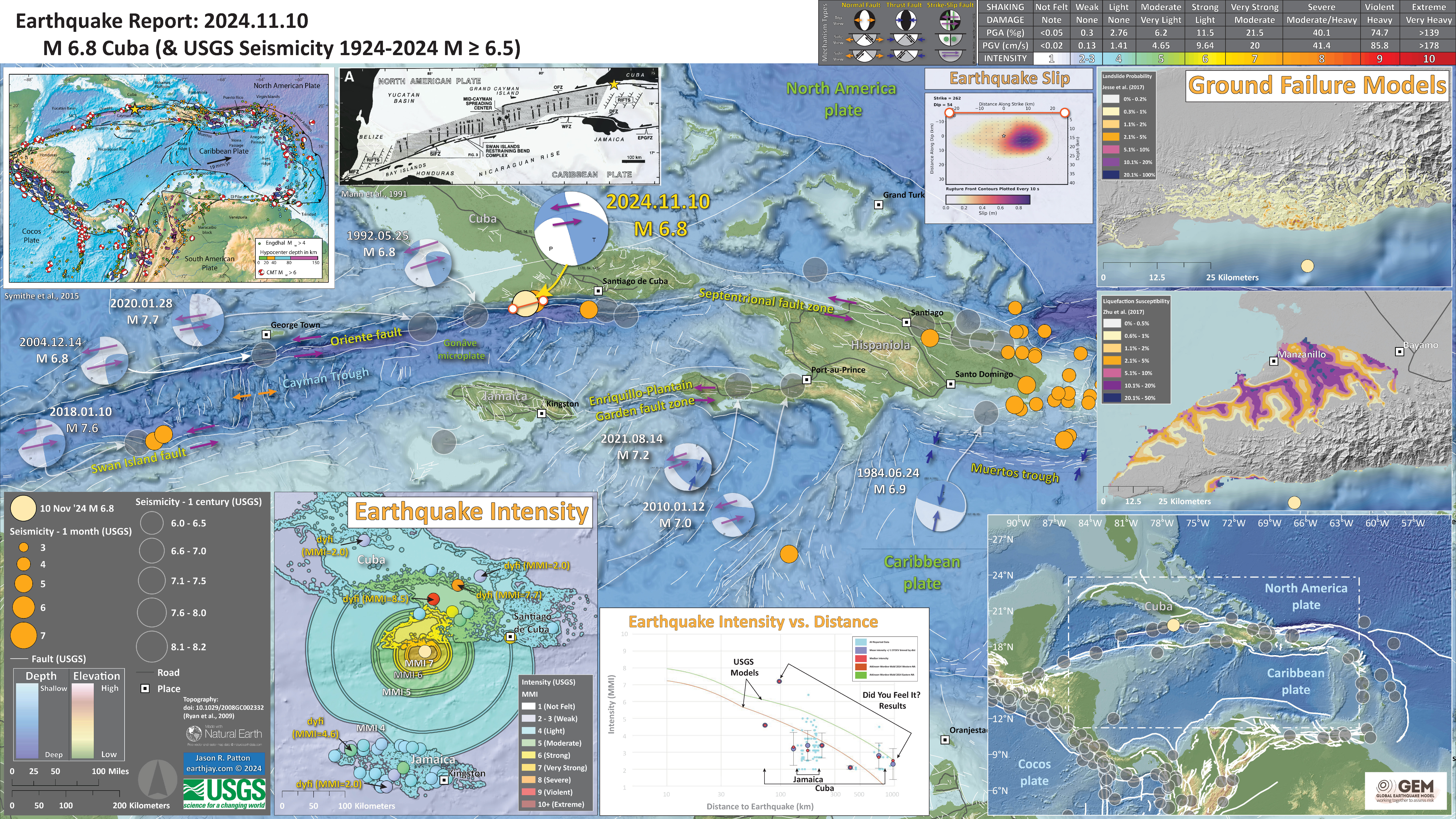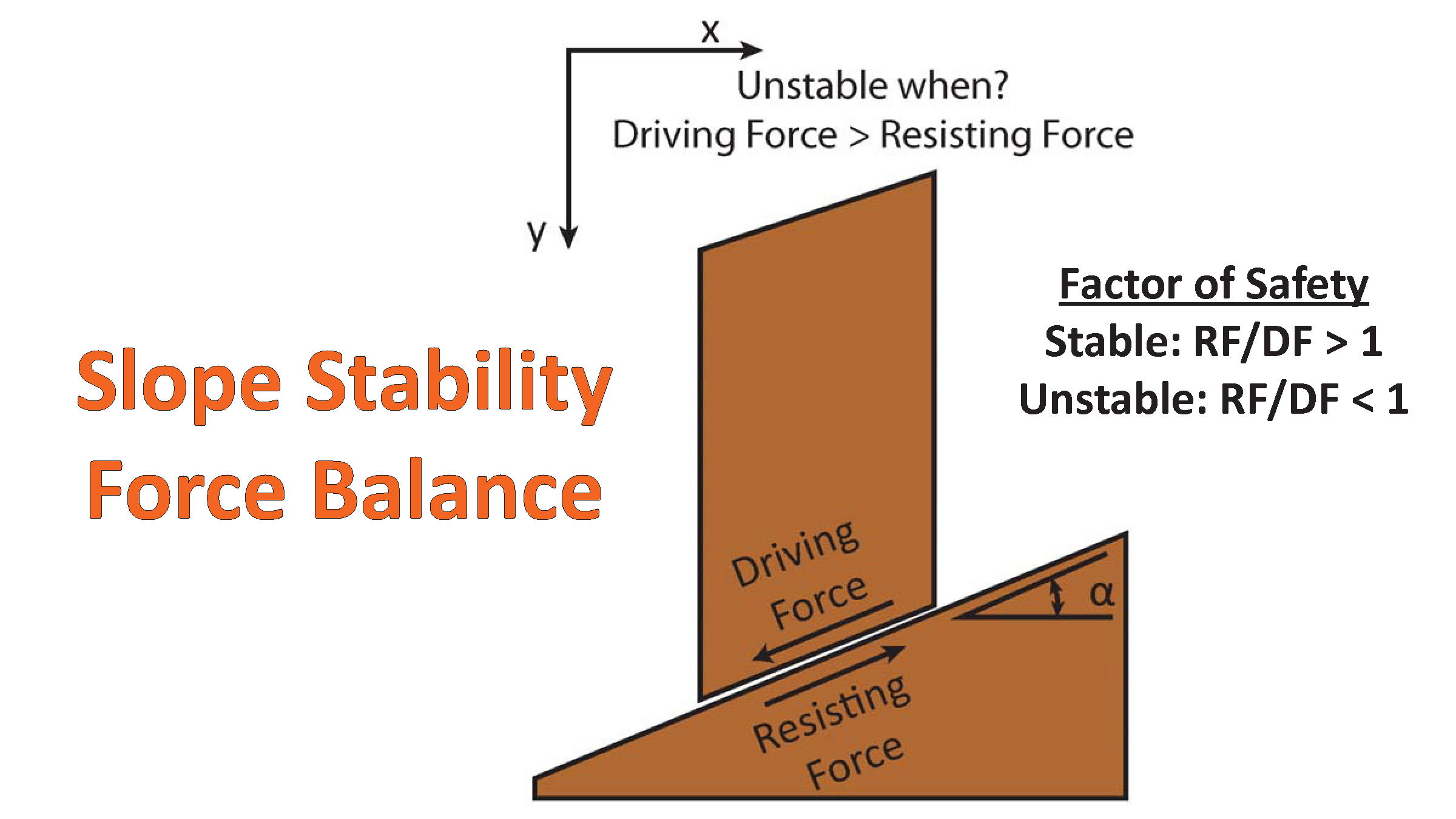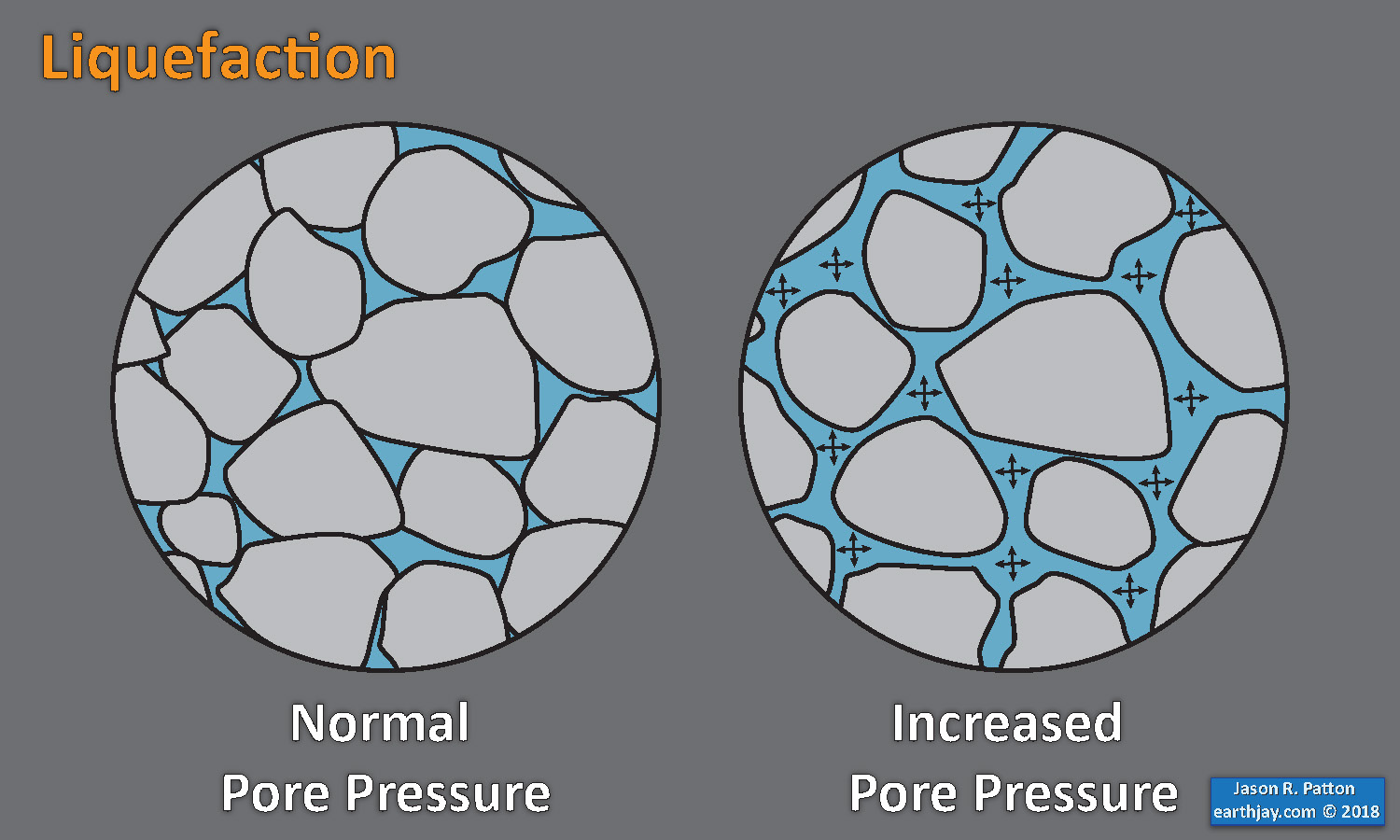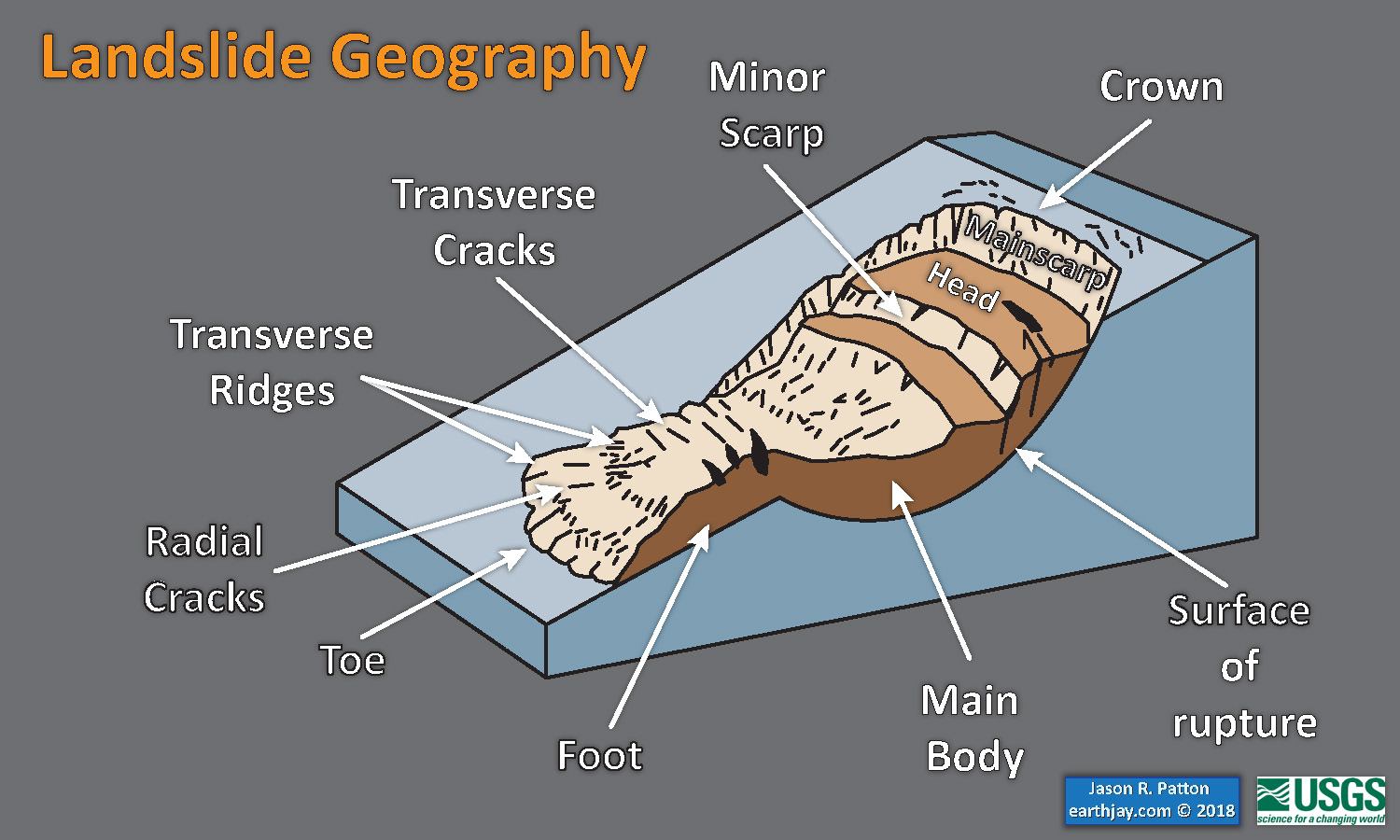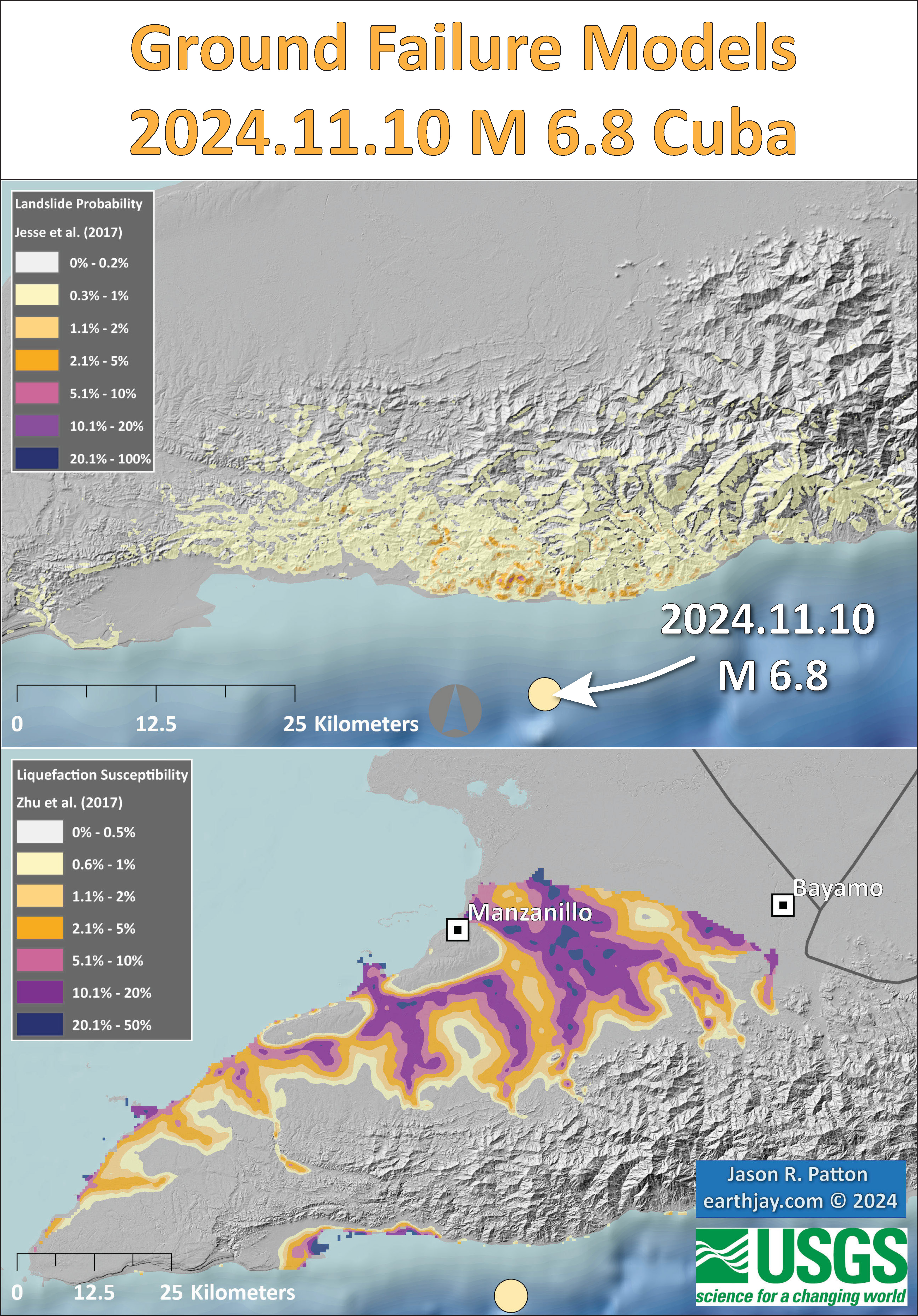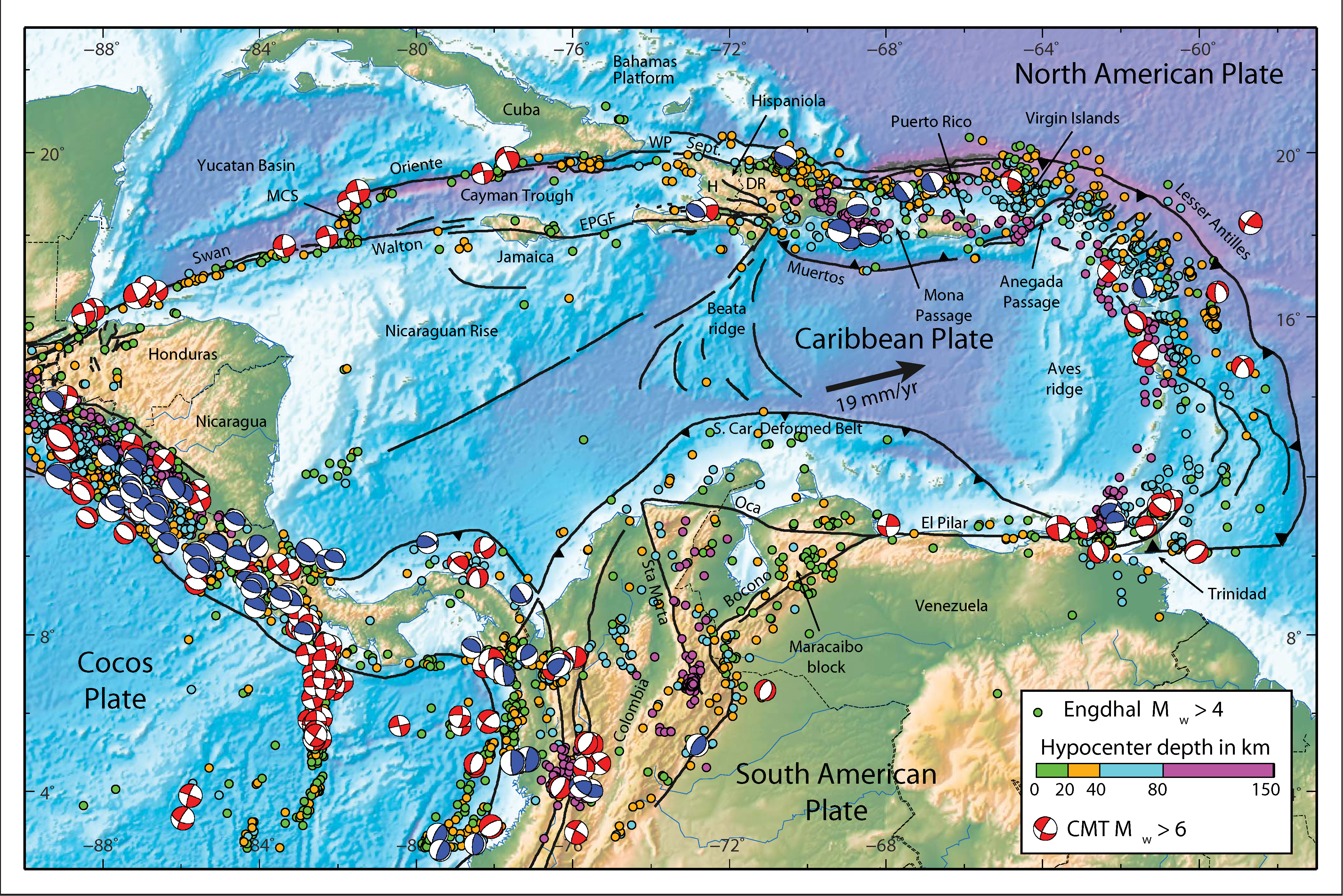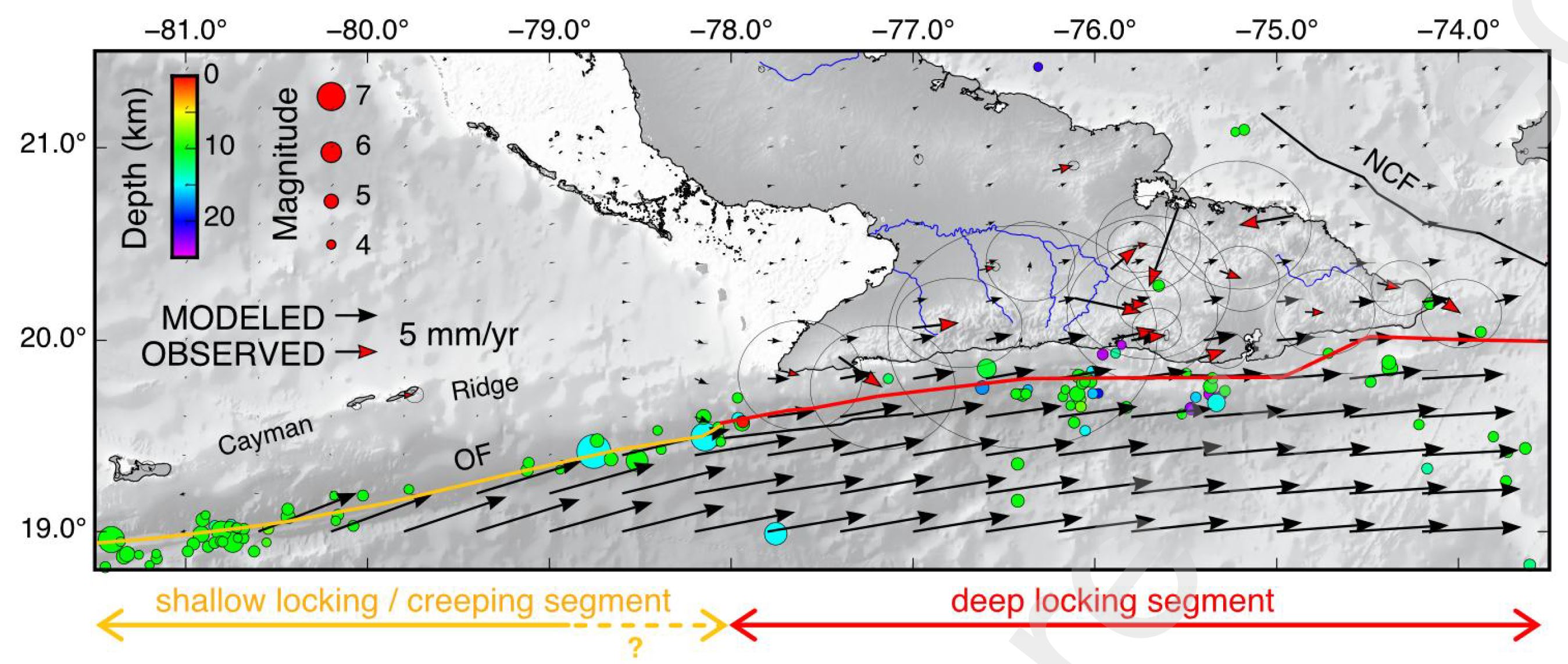Yesterday there was a magnitude M 5.9 earthquake along the south coast of Cuba. Normally I would not take notice, but this event was located along a plate boundary fault.
https://earthquake.usgs.gov/earthquakes/eventpage/us7000nr0n/executive
The Septentrional–Oriente fault is a transform plate boundary where the plates move side-by-side like the San Andreas fault in California, USA. Here the North America plate moves west relative to the Caribbean plate. The Septentrional–Oriente fault (SOF) is a left-lateral strike-slip fault system.
The M 5.9 earthquake mechanism was a strike-slip mechanism that was oriented as left-lateral if it were along the east-west nodal plane. The mechanism was consistent with slip on the SOF. I posted a map on social media.
The plates in this region can be further subdivided into blocks separated by secondary faults. For example, a second major left-lateral strike-slip fault system is the Enriquillo–Plantain Garden fault zone and between these faults is the Gonâve microplate formed at the “Mid-Cayman spreading centre” (an oceanic spreading ridge).
However, shortly after there was a magnitude M 6.8 earthquake in nearly the same location. I had to zoom far in on the map on my phone to see if the M 5.9 and M 6.8 were separate earthquakes.
https://earthquake.usgs.gov/earthquakes/eventpage/us7000nr0v/executive
The M 6.8 earthquake mechanism was also oriented to be left-lateral strike-slip. Then have been three M 4+ earthquakes and they all align in an east-west trending line.
There is a high likelihood that this earthquake sequence was along the SOF.
I monitored the tide gages in the Caribbean, particularly ones that were closest to the earthquakes. Strike-slip earthquakes can generate tsunami, especially if the seafloor is shaped in a way that displaces seawater during the earthquake.
Tsunami from strike-slip earthquakes simply displace less water than subduction zone earthquakes, so generate smaller tsunami. There was a magnitude M 7.7 left-lateral strike-slip earthquake along the SOF at about 150 km to the west of yesterday’s M 6.8 earthquake.
https://earthquake.usgs.gov/earthquakes/eventpage/us60007idc/executive
Here is the earthquake report for the 2020 M 7.7 earthquake. This M 7.7 earthquake generated a tsunami with an amplitude of about 1 meter (vertical distance between the peak and the trough of the tsunami).
There may have been a tsunami from yesterday’s M 6.8 earthquake but it would have been much smaller than the one from the 2020 M 7.7 earthquake, possibly even undetectable.
Below is my interpretive poster for this earthquake
- I plot the seismicity from the past month, with diameter representing magnitude (see legend). I include earthquake epicenters from 1924-2024 with magnitudes M ≥ 3.0 in one version.
- I plot the USGS fault plane solutions (moment tensors in blue and focal mechanisms in orange), possibly in addition to some relevant historic earthquakes.
- A review of the basic base map variations and data that I use for the interpretive posters can be found on the Earthquake Reports page. I have improved these posters over time and some of this background information applies to the older posters.
- Some basic fundamentals of earthquake geology and plate tectonics can be found on the Earthquake Plate Tectonic Fundamentals page.
- In the lower right corner is a map showing the plate tectonic boundaries (from the GEM).
- In the lower left corner is a map that shows the M 6.8 earthquake intensity using the modified Mercalli intensity scale. Earthquake intensity is a measure of how strongly the Earth shakes during an earthquake, so gets smaller the further away one is from the earthquake epicenter. The map colors represent a model of what the intensity may be. The USGS has a system called “Did You Feel It?” (DYFI) where people enter their observations from the earthquake and the USGS calculates what the intensity was for that person. The dots with yellow labels show what people actually felt in those different locations.
- To the right of the intensity map is a plot that shows the same intensity (both modeled and reported) data as displayed on the map. Note how the intensity gets smaller with distance from the earthquake.
- In the upper right corner are two maps showing the possibility of earthquake induced liquefaction for these two earthquakes. I discuss these phenomena in more detail later in the report.
- To the left of the ground failure interpretation maps is the USGS finite fault model for the M 6.8 earthquake. They model slip on a rectangular fault and color represents how much the fault moved (up to about 0.9 meters).
- In the upper left corner is a map from Symithe et al. (2015) showing the plates, their boundaries, and earthquake mechanisms for some significant earthquakes. These mechanisms reveal what type of fault is formed at the plate boundaries.
- To the right of the Symithe map is a map from Mann et al. (1991) that shows the faults and magnetic anomalies that are evidence for the oceanic spreading ridge that forms the Cayman trough.
I include some inset figures. Some of the same figures are located in different places on the larger scale map below.
Other Report Pages
Shaking Intensity
- Here is a figure that shows a more detailed comparison between the modeled intensity and the reported intensity. Both data use the same color scale, the Modified Mercalli Intensity Scale (MMI). More about this can be found here. The colors and contours on the map are results from the USGS modeled intensity. The DYFI data are plotted as colored dots (color = MMI, diameter = number of reports).
- In the upper panel is the USGS Did You Feel It reports map, showing reports as colored dots using the MMI color scale. Underlain on this map are colored areas showing the USGS modeled estimate for shaking intensity (MMI scale).
- In the lower panel is a plot showing MMI intensity (vertical axis) relative to distance from the earthquake (horizontal axis). The models are represented by the green and orange lines. The DYFI data are plotted as light blue dots. The mean and median (different types of “average”) are plotted as orange and purple dots. Note how well the reports fit the green line (the model that represents how MMI works based on quakes in California).
- Below the map and the lower plot is the USGS MMI Intensity scale, which lists the level of damage for each level of intensity, along with approximate measures of how strongly the ground shakes at these intensities, showing levels in acceleration (Peak Ground Acceleration, PGA) and velocity (Peak Ground Velocity, PGV).
Potential for Ground Failure
- Below are a series of maps that show the potential for landslides and liquefaction. These are all USGS data products.
- There are many different ways in which a landslide can be triggered. The first order relations behind slope failure (landslides) is that the “resisting” forces that are preventing slope failure (e.g. the strength of the bedrock or soil) are overcome by the “driving” forces that are pushing this land downwards (e.g. gravity). The ratio of resisting forces to driving forces is called the Factor of Safety (FOS).
- Below is the liquefaction susceptibility and landslide probability map (Jessee et al., 2017; Zhu et al., 2017). Please head over to that report for more information about the USGS Ground Failure products (landslides and liquefaction). Basically, earthquakes shake the ground and this ground shaking can cause landslides.
- I use the same color scheme that the USGS uses on their website. Note how the areas that are more likely to have experienced earthquake induced liquefaction are in the valleys. Learn more about how the USGS prepares these model results here.
- Below are maps showing a comparison between the USGS modeled earthquake triggered landslides and liquefaction potential with the Centre Nationale De Information Géospatiale (CNIGS) probabilistic models of ground failure.
We can write this ratio like this:
FOS = Resisting Force / Driving Force
When FOS > 1, the slope is stable and when FOS < 1, the slope fails and we get a landslide. The illustration below shows these relations. Note how the slope angle α can take part in this ratio (the steeper the slope, the greater impact of the mass of the slope can contribute to driving forces). The real world is more complicated than the simplified illustration below.
Landslide ground shaking can change the Factor of Safety in several ways that might increase the driving force or decrease the resisting force. Keefer (1984) studied a global data set of earthquake triggered landslides and found that larger earthquakes trigger larger and more numerous landslides across a larger area than do smaller earthquakes. Earthquakes can cause landslides because the seismic waves can cause the driving force to increase (the earthquake motions can “push” the land downwards), leading to a landslide. In addition, ground shaking can change the strength of these earth materials (a form of resisting force) with a process called liquefaction.
Sediment or soil strength is based upon the ability for sediment particles to push against each other without moving. This is a combination of friction and the forces exerted between these particles. This is loosely what we call the “angle of internal friction.” Liquefaction is a process by which pore pressure increases cause water to push out against the sediment particles so that they are no longer touching.
An analogy that some may be familiar with relates to a visit to the beach. When one is walking on the wet sand near the shoreline, the sand may hold the weight of our body generally pretty well. However, if we stop and vibrate our feet back and forth, this causes pore pressure to increase and we sink into the sand as the sand liquefies. Or, at least our feet sink into the sand.
Below is a diagram showing how an increase in pore pressure can push against the sediment particles so that they are not touching any more. This allows the particles to move around and this is why our feet sink in the sand in the analogy above. This is also what changes the strength of earth materials such that a landslide can be triggered.
Below is a diagram based upon a publication designed to educate the public about landslides and the processes that trigger them (USGS, 2004). Additional background information about landslide types can be found in Highland et al. (2008). There was a variety of landslide types that can be observed surrounding the earthquake region. So, this illustration can help people when they observing the landscape response to the earthquake whether they are using aerial imagery, photos in newspaper or website articles, or videos on social media. Will you be able to locate a landslide scarp or the toe of a landslide? This figure shows a rotational landslide, one where the land rotates along a curvilinear failure surface.
- Here is the tectonic map from Symithe et al. (2015). I include their figure caption below in blockquote.
- Here is the tectonic map from Garcia-Casco et al. (2011). I include their figure caption below in blockquote.
- This is another map showing earthquake history, fault location, and earthquake slip direction from Calais et al. (2016). Note how the relative plate motion near Puerto Rico is oriented parallel to the plate boundary (the Puerto Rico trench). This suggests that most of the plate motion would result in strike-slip earthquakes. However, the relative motion is oblique, so subduction zone earthquakes are still possible.
- Here is a map from Calais et al., 2023 that shows the regional tectonics of the Greater Antilles.
- From top to bottom, the maps show the seismicity, the earthquake mechanisms, and the GPS plate velocities (see more about geodesy further down in the report).
- Here is a map from Calais et al., 2023 that shows the earthquake mechanisms associated with the Oriente fault.
- Most of the mechanisms show the left-lateral strike-slip motion along this fault. Though there are some compressional mechanisms (reverse faults) that are in places where the strike-slip fault changes orientation in a way that causes compression.
- Here is the map from Mann et a. (1991). Note how today’s earthquake is in an area that may have overlapping faults of different types.
- This is a map from ten Brink et al., 2002. Earthquake mechanisms are plotted for events along the Oriente, Sean Island, and Walton faults along the Cayman trough.
- This map shows the gravity anomaly map for the region from ten Brink et al. (2002).
- Gravity data can reveal the subsurface structures.
Some Relevant Discussion and Figures
Seismotectonic setting of the Caribbean region. Black lines show the major active plate boundary faults. Colored circles are precisely relocated seismicity [1960–2008, Engdahl et al., 1998] color coded as a function of depth. Earthquake focal mechanism are from the Global CMT Catalog (1976–2014) [Ekstrom et al., 2012], thrust focal mechanisms are shown in blue, others in red. H = Haiti, DR = Dominican Republic, MCS = mid-Cayman spreading center, WP = Windward Passage, EPGF = Enriquillo Plaintain Garden fault.
Plate tectonic configuration of the Caribbean region showing the location of the study cases presented in this issue (numbers refer to papers, arranged as in the issue), and other important geological features of the region (compiled from several sources).
Seismicity and kinematics of the NE Caribbean. The inset shows Caribbean and surrounding plates, red arrows show relative motions in cm/yr: a: NEIC seismicity 1974–2015 is shown with circles colored as a function of depth, stars show large (M > 7) instrumental and historical earthquakes; b: red and blue bars show earthquake slip vector directions derived from the gCMT database [www.globalcmt.org], black arrows show the present-day relative motion of the NA plate with respect to the Caribbean.
Seismotectonic and plate kinematic setting of the Northern Caribbean plate boundary. Top: 1978 to 2023 seismicity along the Northern Caribbean plate boundary according to the USGS/NEIC catalog, M>3. Note the earthquake cluster north of Cuba (81oW/21oN) and the M<6 events along the western continuation of the Puerto Rico -- North Hispaniola trench round 75oW/20.5oN), which are discussed in the text. Center: source mechanisms for earthquakes with a moment magnitude greater than 6, according to the gCMT catalog. Bottom: GNSS-derived velocities with respect to the Caribbean plate. Note the transition from shallow strike-slip events and plate boundary kinematics west of ~74oW, to a combination of strike-slip and plate-boundary-shortening east of that longitude. OF: Oriente fault, WP: Windward Passage, SF: Septentrional fault, EPG: Enriquillo-Plantain Garden fault, NHF: North Hispaniola fault, PRT: Puerto Rico trench, MT: Muertos trench, CSC: Cayman spreading center, PR: Puerto Rico.
Seismotectonic map of Cuba and its surrounding showing the major active and potentially active faults (discussion in the text), the location of the GNSS sites (continuous and episodic) used in this study, the M>3 seismicity from 1978 to 2023 from the USGS/NEIC catalog, and the focal mechanisms for M>5 earthquakes from the CMT database. One exception is the Mw4.7, Dec 17 2022 normal faulting on a NE-SW oriented fault plane off the North Cuban fault at the toe of the Bahamas Platform. CCB: Cabo Cruz basin, SDB: Santiago Deformed Belt.
A. Tectonic map of Cayman trough region showing strike-slip faults (heavy lines), oceanic crust (gray) in Cayman trough, and magnetic anomaly identifications (numbered bars) (after Rosencrantz et a., 1988). Arrows show relative displacement directions. Fault zones: OFZ – Oriente; DFZ- Dunvale; EPGFZ – Enriquillo-Plantain Garden; WFZ – Walton; SIFZ – Swan Islands; MFZ – Motagua. Bl. Late Miocene reconstruction of Cayman trough. C. Early Miocene reconstruction.
(a) Major morphologic features of the Caribbean plate and its vicinity. Bathymetric data is from ETOPO-5 database. Region inside box is the study area shown in Figs. 1(b) and 4(a),(b). Tectonic interpretation is modified from Mann, Schubert, and Burke (1990). Black arrow: Caribbean plate motion relative to North America. Red arrows: plate motion vectors relative to a hotspot reference (Gripp & Gordon, 1990). (b) General bathymetry of Cayman Trough and its vicinity from ETOPO-5 database and the major faults bounding the trough. Earthquake locations are from the NGDCs Preliminary Determination of Epicenters
database.
(a) Free-air gravity anomaly map of the central Cayman Trough derived from satellite altimetry data (Sandwell and Smith, 1997). Grid spacing is 1 min. Contour interval is 10 mGal. The locations of the east-west profile along Cayman Trough in Figs. 4(c) and 5 and of profiles B–B0 , and C–C0 in Fig. 4(c) are shown as gray lines. Heavy black lines: Caribbean–North America plate boundary. O, S, and X: locations where rocks with oceanic crust affinity, serpentinized peridotite, and continental crust affinity were dredged, respectively (Perfit and Heezen, 1978). H: locations of heat flow measurements shown in Fig. 8. Numbered lines with open circles are locations of two-ship reversed seismic refraction profiles of Ewing et al. (1960). (b) Free-air gravity anomaly map of the central Cayman Trough from shipboard gravity data. Tracklines and individual points that were used to create the map are shown as thin lines and dots. Heavy lines are as in Fig. 4(a). The data were gridded at 1-min blocks. See text for further details about the processing. (c) Comparison between satellite (solid line) and shipboard (short-dashed line) free-air gravity anomalies derived from their respective gridded data sets along the profiles shown in Fig. 4(a) and (b). The actual shipboard gravity measurements along profiles B–B0 and C–C0 (long-dashed lines) are shown for comparison. The origin in profiles B–B0 and C–C0 is located at their crossings with the east–west profile.
- This plot shows the GPS observations in the Caribbean. Symithe et al. (2015) used these data to estimate the amount of seismogenic coupling (how much the faults are “locked”) in the region.
- Here are some plots showing GPS motion rates relative to topography and seismicity in the region (Symithe et al., 2015).
- First, look at the profile that crosses Haiti, A-A’ (south to north, from left to right). The profile for Haiti clearly shows steps in the GPS velocity profiles. This is evidence for strike-slip faults as tectonic strain from relative plate motions is accumulated along fault boundaries, there are steps in the plate motion rates. These steps are located where the profile crosses two major strike slip faults in Haiti.
- The evidence for a strike-slip fault along profile A-A’ is at about 250 km (horizontal axis). This is the SOF that trends towards the southern boundary of Cuba.
- This is a larger scale view of GPS site motion in the region from Calais et al. (2016).
- This map (Symithe et al., 2015) shows vectors that are modeled plate motions.
- Note the vectors along the east-west striking faults on the south side of Cuba are all pointing to the east. This means that the plate on the southern side of the fault is moving to the east relative to the plate to the north.
- Here is a map from Calais et al., 2023 that shows the relative motion of Cuba in a western direction.
- Here is a map from Calais et al., 2023 that shows the relative motion of the plate south of the Oriente fault in a eastern direction.
Geodesy
Geodesy is the study of how the Earth deforms with time. This science goes back many years and has been based on different types of technology through time.
The basic principle is that measurements are made between positions on the surface of the Earth. These same measurements are made at a later time. If the positions moved over time, we can estimate the rate of movement for that position.
Modern geodetic technology is in the form of GPS or GNSS observations made for these positions (sometimes called “benchmarks”),
The maps below have GPS observations for benchmarks across the Caribbean. The rates of motion are represented by arrows.
These arrows have a direction that they point that represents the direction these positions are moving and have a length that represents the rate (the speed, or velocity) that the benchmark is moving.
These arrows are called vectors. The vectors show the direction the different plates move, relative to a fixed reference frame. Every vector is measured relative to some position somewhere.
(top) GPS velocities used in the model shown with respect to the North American plate defined by the velocity of 25 GPS sites located in the stable interior of the plate [Calais et al., 2006]. (bottom) GPS velocities shown with respect to the Caribbean plate as defined in the best fit block model described in the text. Error ellipses are 95% confidence. Blue arrows show GPS velocities from Pérez et al. [2001] in Venezuela because of their large uncertainty and the lack of common sites with our solution, which prevents us from rigorously combining them to our solution. They are not used in the model but used to show that they are consistent with the rest of the velocity field.
Sections across the Lesser and Greater Antilles subduction showing topography (grey line), earthquake hypocenter [Engdahl et al., 1998], velocity magnitude at the GPS sites (red circles with 95% confidence error bar), velocity predicted by the best fit model (solid red line), and velocity predicted by a forward model where we impose full coupling on the subduction interface (dashed blue line). The misfit of the data to a fully locked plate interface is apparent on the three Lesser Antilles cross sections.
Velocities at selected GPS sites in the NE Caribbean shown with respect to the Caribbean plate (a) and to the North American plate (b). Error ellipses are 95% confidence.
Best fit model geometry with block boundaries as solid black lines and predicted relative block motions as arrows with velocity indicated in mm/yr with their 95% confidence ellipse according to the parameters listed in Table 2. Red = strike slip (i.e., slip direction with ±30o from fault strike), blue = reverse or transpressional, green = normal of transtensional. Residual velocities are shown with grey arrows. We omitted their error ellipses for a sake of readability, see Figures 9 and 10 for a close up view on Hispaniola and the Lesser Antilles. The thin dashed line indicates the boundary of the Bahamas Platform.
Horizontal velocities at continuous GNSS sites shown with respect to ITRF14 (2000-01-05 to 2023-02-01 time interval). Error ellipses are 95% confidence. Note the regionally consistent overall pattern, with ~10 mm/yr of motion to the NW to WNW. Site SSPI is an outlier resulting from the short data span available or to local site instability (see text). SDB: Santiago Deformed Belt.
Predictions of the best fit elastic block model (black arrows) and comparison with GPS observations (red arrows). Note (1) the eastward motion of the Gonave microplate, south of the Orience fault (OF) at 10 mm/yr, (2) the sharp transition in model and observed velocities across the Cayman ridge segment of the Oriente fault, (3) the broad velocity gradient across the eastern Cuba segment of the Oriente fault. Colored circles show the M>3 seismicity from 1978 to 2023 from the USGS/NEIC catalog. Note the sharp transition between the shallow and deep locking segments of the Oriente faults is the one used in this particular model. In actuality, the locus of that transition is poorly defined from the data at hand and may occur further west, as indicated by the January 2020, M7.8 earthquake epicenter around 79oW.
- McHugh et al. (2024) conducted a paleoseismic investigation (study of prehistoric earthquakes) along the Enriquillo–Plantain Garden fault.
- This is the strike-slip fault that crosses southern Hispaniola (e.g., the 2010 and 2021 earthquakes in Haiti) and trends through Jamaica and then south of Cuba.
- Dr. McHugh led her collaborators to collect bathymetry data, seismic profile data, and sediment cores. The map on the bottom shows the seismic reflection profiles and core locations.
- This is a map that shows the seismic reflection profile locations for the seismic reflection profiles in the center of this figure.
- A lithologic log is shown for one of their cores.
- Here is a diagram called a space time diagram. The vertical axis represents time into the past (from 0 to 10,000 years ago). The horizontal axis represents location, west to east from left to right.
- The sedimentary evidence for earthquakes is plotted as colored rectangles. Each colored rectangle represents an earthquake in a particular location at a particular time.
- The gray bars represent how these authors correlate earthquake records from location to location. This diagram represents a 10,000 year earthquake prehistory.
Paleoseismology
A) Overview of setting and seismicity in the Caribbean. Caribbean plate motion relative to North American plate is 2 cm/yr, from Calais et al., 2022. (B) Detail of northern Caribbean plate boundary with location of our study area (white box) and Haiti 2010 Mw 7.0, Nippes 2021 Mw 7.2, and Oriente Fault (OF) 2020 Mw 7.7 ruptures (stars; USGS, 2020). SF—Septentrional Fault; DR—Dominican Republic; EPGF—Enriquillo–Plantain Garden Fault; WF—Walton Fault; CSC—Cayman Spreading Center. (C) Multibeam bathymetry (Leroy et al., 2015; R/V Pelican 2022 [red tracks] and R/V L’Atalante 2012 surveys [blue]) with location of Morant, Navassa, and Matley Basins and study areas offshore Kingston, Jamaica, and east of island of Jamaica.
Morant Basin. (A) Multibeam bathymetry from Leroy et al. (2015) with navigation tracks, core locations, and trace of Enriquillo–Plantain Garden Fault (EPGF). Red tracks indicate multichannel seismics (MCS) collected with the R/V Pelican in 2022: blue MCS from the R/V L’Atlante 2012. Red dots are R/V Pelican cores; yellow dots, 14C-dated cores (MC—multicore). (B) MCS revealing an erosional unconformity (purple) marking transition from transtensional Paleogene to transpressional Neogene (Leroy et al., 2015). Orange reflectors show evidence of prior extensional regime. Folding is most prominent in Navassa Basin but subtle in western Morant Basin. Significant vertical offset marks Enriquillo–Plantain Garden Fault (EPGF, red line) at seafloor, showing the fault is active. Scarps and sediment ponding suggest large seismogenic displacements of EPGF consistent with event deposits identified in cores. TWT—two-way travel time; CDP—common depth point; V/H—vertical/horizontal. (C) Notable event deposit highlighting contrasting lithologies in core PE22-17-GC02-2, 80–120 cm. From right to left are core photo and X-ray image (central vertical stripe) of Section 2/5, and event deposit with interpretation (core log in Fig. S3 [see text footnote 1]).
Time (10 k.y.)–space (9230 km) plot of 58 event deposits (EDs) along Enriquillo–Plantain Garden Fault (EGPF) in Jamaica Passage, east of Jamaica island and offshore of Kingston. Core locations are projected on east-west line with EDs marked by their 95% confidence range (see Table S1 [see text footnote 1]). Two or more EDs may be part of a sequence when their 95% confidence ranges overlap. Gray bands highlight groups of EDs interpreted as having strong (dark gray) and weak (light gray) age correlation. A weak correlation is interpreted if two or three sites are correlated by age but are spatially apart with many sites in between that don’t see the event. Each band may represent a sequence of earthquakes or a single large rupture along the EPGF. Thickness of bands marks groups’ age range. Fifty-eight EDs were identified, and 50 of them are correlated in 12 groups, each group possibly representing earthquakes. Four of these groups occur in the same basin where distance between cores is 8–12 km; eight of them are in multiple basins including two that span three basins from Navassa to offshore Kingston. Eight EDs cannot be correlated. Planktonic and benthic foraminifers were measured from same core and interval to determine 14C differences in surface and bottom waters. There are no major differences since most of the ages overlap. Future studies will focus on this paleoceanography result. MC—multicore.
- 2016.01.17 1900-2016 Summary northern Caribbean
- 2024.11.10 M 6.8 Cuba
- 2021.08.14 M 7.2 Haiti
- 2020.01.28 M 7.7 Cayman Islands
- 2020.01.07 M 6.4 Puerto Rico
- 2019.09.24 M 6.0 Puerto Rico (Mona Passage) Poster
- 2018.08.21 M 7.3 Venezuela
- 2018.01.10 M 7.6 Cayman Trough
- 2016.01.17 M 5.1 pair Cuba
- 2010.01.12 M 7.0 Haiti
Caribbean
General Overview
Earthquake Reports
Social Media
- Frisch, W., Meschede, M., Blakey, R., 2011. Plate Tectonics, Springer-Verlag, London, 213 pp.
- Hayes, G., 2018, Slab2 – A Comprehensive Subduction Zone Geometry Model: U.S. Geological Survey data release, https://doi.org/10.5066/F7PV6JNV.
- Holt, W. E., C. Kreemer, A. J. Haines, L. Estey, C. Meertens, G. Blewitt, and D. Lavallee (2005), Project helps constrain continental dynamics and seismic hazards, Eos Trans. AGU, 86(41), 383–387, , https://doi.org/10.1029/2005EO410002. /li>
- Jessee, M.A.N., Hamburger, M. W., Allstadt, K., Wald, D. J., Robeson, S. M., Tanyas, H., et al. (2018). A global empirical model for near-real-time assessment of seismically induced landslides. Journal of Geophysical Research: Earth Surface, 123, 1835–1859. https://doi.org/10.1029/2017JF004494
- Kreemer, C., J. Haines, W. Holt, G. Blewitt, and D. Lavallee (2000), On the determination of a global strain rate model, Geophys. J. Int., 52(10), 765–770.
- Kreemer, C., W. E. Holt, and A. J. Haines (2003), An integrated global model of present-day plate motions and plate boundary deformation, Geophys. J. Int., 154(1), 8–34, , https://doi.org/10.1046/j.1365-246X.2003.01917.x.
- Kreemer, C., G. Blewitt, E.C. Klein, 2014. A geodetic plate motion and Global Strain Rate Model in Geochemistry, Geophysics, Geosystems, v. 15, p. 3849-3889, https://doi.org/10.1002/2014GC005407.
- Meyer, B., Saltus, R., Chulliat, a., 2017. EMAG2: Earth Magnetic Anomaly Grid (2-arc-minute resolution) Version 3. National Centers for Environmental Information, NOAA. Model. https://doi.org/10.7289/V5H70CVX
- Müller, R.D., Sdrolias, M., Gaina, C. and Roest, W.R., 2008, Age spreading rates and spreading asymmetry of the world’s ocean crust in Geochemistry, Geophysics, Geosystems, 9, Q04006, https://doi.org/10.1029/2007GC001743
- Pagani,M. , J. Garcia-Pelaez, R. Gee, K. Johnson, V. Poggi, R. Styron, G. Weatherill, M. Simionato, D. Viganò, L. Danciu, D. Monelli (2018). Global Earthquake Model (GEM) Seismic Hazard Map (version 2018.1 – December 2018), DOI: 10.13117/GEM-GLOBAL-SEISMIC-HAZARD-MAP-2018.1
- Silva, V ., D Amo-Oduro, A Calderon, J Dabbeek, V Despotaki, L Martins, A Rao, M Simionato, D Viganò, C Yepes, A Acevedo, N Horspool, H Crowley, K Jaiswal, M Journeay, M Pittore, 2018. Global Earthquake Model (GEM) Seismic Risk Map (version 2018.1). https://doi.org/10.13117/GEM-GLOBAL-SEISMIC-RISK-MAP-2018.1
- Storchak, D. A., D. Di Giacomo, I. Bondár, E. R. Engdahl, J. Harris, W. H. K. Lee, A. Villaseñor, and P. Bormann (2013), Public release of the ISC-GEM global instrumental earthquake catalogue (1900–2009), Seismol. Res. Lett., 84(5), 810–815, doi:10.1785/0220130034.
- Zhu, J., Baise, L. G., Thompson, E. M., 2017, An Updated Geospatial Liquefaction Model for Global Application, Bulletin of the Seismological Society of America, 107, p 1365-1385, https://doi.org/0.1785/0120160198
- Bruna, J.L.G., ten Brink, U.S., Munoz-Martin, A., Carbo-Gorosabel, A., and Estrada, P.L., 2015. Shallower structure and geomorphology of the southern Puerto Rico offshore margin in Marine and Petroleum Geology, v. 67, p. 30-56, http://dx.doi.org/10.1016/j.marpetgeo.2015.04.014
- Calais, E., Symithe, S., de Lepinay, B.B., Prepetit, C., 2016. Plate boundary segmentation in the northeastern Caribbean from geodetic measurements and Neogene geological observations in Comptes Rendus Geoscience, v. 348, p. 42-51, http://dx.doi.org/10.1016/j.crte.2015.10.007
- E. Calais(1), O.F. Gonzalez(2), E.D. Arango-Arias(2), B. Moreno(2), R. Palau(2), M. Cutie(2), E. Diez(2), C. 5 Montenegro(2), E. Rodriguez Roche(3), J. Garcia(3), E. Castellanos(4), S. Symithe(5,6, 2023. Current deformation along the northern Caribbean plate boundary from GNSS measurements in Cuba in Tectonophysics, v. 868, https://doi.org/10.1016/j.tecto.2023.230068
- Leroy, S., et al., 2015, Segmentation and kinematics of the North America–Caribbean plate boundary offshore Hispaniola: Terra Nova, v. 27, p. 467–478, https://doi.org/10.1111/ter.12181.
- Manaker, D.M., Calais, E., Freed, A.M., Ali, S.T., Przybylski, P., Mattioli, G., Jansma, O., Prepetit, C., de Chabalier, J.B., 2008. Interseismic Plate coupling and strain partitioning in the Northeastern Caribbean in GJI, v. 174, p. 889-903, doi: 10.1111/j.1365-246X.2008.03819.x
- McHugh, C.M., et al., 2024, Sedimentary signatures of large earthquakes along the submerged Enriquillo–Plantain Garden transpressional plate boundary, northern Caribbean: Geology, v. 52, p. 769–773, https://doi.org/10.1130/G52258.1
- Piety, L.A., Redwine, J.R., Derouin, S.A., Prentice, C.S., Kelson, K.I., Klinger, R.E., and Mahan, S., 2018. Holocene Surface Ruptures on the Salinas Fault and Southeastern Great Southern Puerto Rico Fault Zone, South Coastal Plain of Puerto Rico in BSSA, v. 108, no. 2, p. 619-638, doi: 10.1785/0120170182
- Symithe, S., E. Calais, J. B. de Chabalier, R. Robertson, and M. Higgins, 2015. Current block motions and strain accumulation on active faults in the Caribbean, J. Geophys. Res. Solid Earth, 120, 3748–3774, doi:10.1002/2014JB011779.
- Xu, X., Keller, G.R., and Guo, X., 2015. Dip variations of the North American and North Caribbean Plates dominate the tectonic activity of Puerto Rico–Virgin Islands and adjacent areas in Geological Journal, doi: 10.1002/gj.2708
References:
Basic & General References
Specific References
Return to the Earthquake Reports page.
- Sorted by Magnitude
- Sorted by Year
- Sorted by Day of the Year
- Sorted By Region
